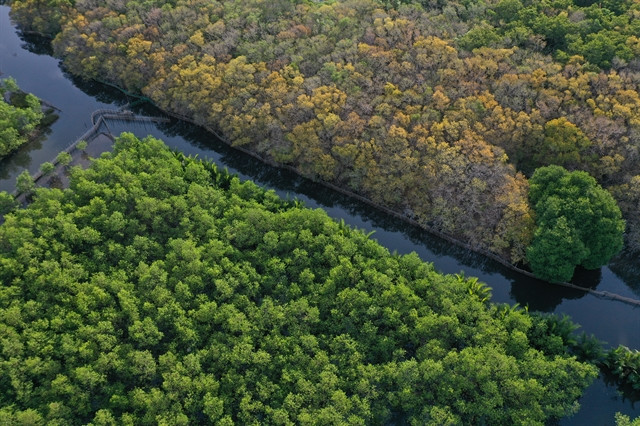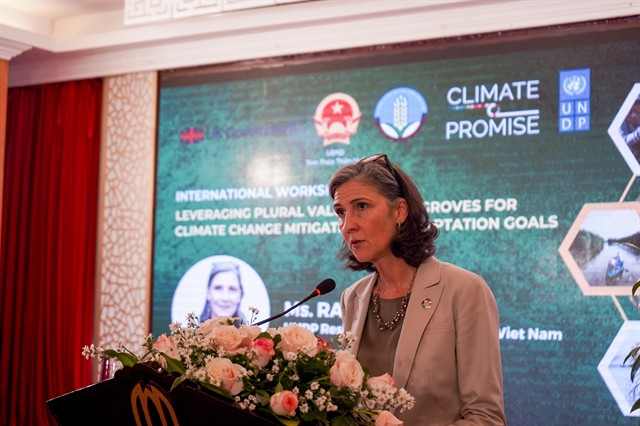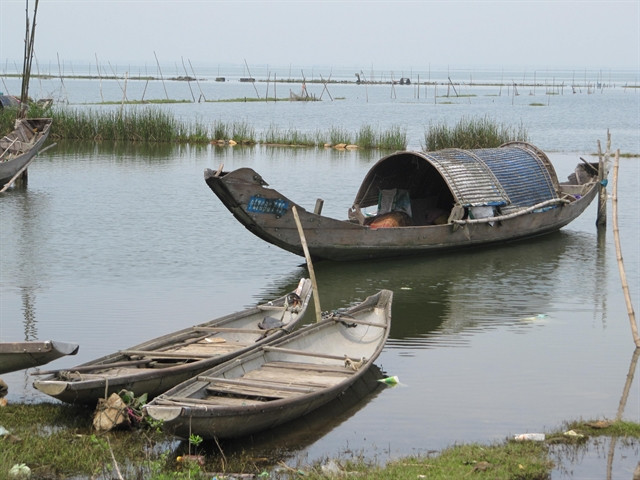 |
| Rú Chá, a wetland forest in Thừa Thiên Huế Province, plays an important role in protecting the environment and communities from disaster and climate change. Photo courtesy of Hồ Cầu |
Mangrove forests are a precious resource for local communities and a significant component of ‘blue carbon’ ecosystems, making them a valuable asset in the context of sustainable carbon financing and climate change mitigation.
The important role of mangrove forest was shared at an international workshop: ‘Leveraging Plural Values of Mangroves for Climate Change Mitigation and Adaptation Goals’, which was hosted by the Ministry of Agriculture and Rural Development (MARD), the United Nations Development Programme (UNDP), and Thừa Thiên Huế provincial People’s Committee, with the participation of global experts, government officials, and local stakeholders.
The event created an opportunity for global south countries to learn good practices and share lessons and experiences relating to mangrove forest management, protection and development, the inclusion of mangroves in the Nationally Determined Contributions (NDCs), and harnessing the potential of mangroves’ blue carbon by financing mangrove protection and restoration efforts.
Participants explored the multifaceted role of mangroves in environmental and community well-being during the two-day event.
Deputy Minister of Agriculture and Rural Development Nguyễn Quốc Trị emphasised the Vietnamese government's dedication to enhancing forest management policies. He highlighted the importance of improving the effectiveness and economic value of coastal mangrove forests in Việt Nam.
"The ministry will continue to direct specialised units to refine forestry policy mechanisms for governmental approval and develop technical guidelines. I urge coastal provinces to intensify forest protection and coastal afforestation efforts," he said.
 |
| Ramla Khalidi, UNDP Việt Nam Resident Representative, presented a speech at the international workshop ‘Leveraging Plural Values of Mangroves for Climate Change Mitigation and Adaptation Goals’ in Thừa Thiên Huế Province. Photo courtesy of UNDP |
Ramla Khalidi, UNDP Việt Nam Resident Representative, praised Việt Nam's leadership in mangrove conservation. She highlighted collaborative projects undertaken with MARD, including the planting and rehabilitating of over 4,000ha of mangrove forests, and an upcoming project financed by Canada to protect and generate an additional 600ha.
She also mentioned the collaboration under UNDP's Climate Promise, supported by the UK Government, to conduct carbon stock assessments across Việt Nam's 28 coastal provinces and identify sustainable financing pathways and the potential of high-integrity carbon markets under future implementation of the Paris Agreement’s Articles 6.2 and 6.4. by the province.
"The rapid loss of mangroves poses a severe threat to coastal resilience, biodiversity, and the livelihoods of millions of people who depend on these ecosystems for sustenance. The restoration of mangroves is not merely an environmental imperative; it is a moral obligation to future generations," she highlighted.
Alex White, Department of Environment, Food & Rural Affairs, the United Kingdom, said: "The UK recognises the importance of mangrove forests in addressing climate change, biodiversity loss, and sustainable development, and their valuable role in supporting climate resilient and nature positive green growth. Our collaboration with the UNDP on forests, land use and nature centres on understanding the benefits of these important ecosystems, and it is good to see examples of our joint work in Việt Nam.”
Clea Paz-Rivera from UNDP underscored the global significance of mangroves in carbon sequestration and coastal protection.
Vũ Tấn Phương from the Việt Nam Forest Certification Office (VFCO) presented the critical role of Việt Nam's forestry sector in carbon storage and emission reduction, the forestry development strategy, and GHG mitigation measures that align with the Nationally Determined Contributions (NDCs) for climate targets.
He also shared the carbon market development plan that focuses on creating a legal framework and infrastructure for carbon trading, aiming to engage the private sector in low-carbon economy development and leverage business competitiveness.
 |
| Fishing boats dock at Phú Lộc fishing community in Thừa Thiên Huế Province. Fishing communities earn their living from seafood resources in the Tam Giang-Cầu Hai lagoon system. VNS Photo Cộng Thàn |
Experts from Sri Lanka and Indonesia also provided insights on mangrove rehabilitation initiatives in their respective countries, emphasising the urgency of preserving these vital ecosystems in the face of global climate challenges.
Maitreyee Mukherjee, an expert from Singapore, analysed carbon markets, carbon taxes and Emission Trading Systems (ETS) and their potential role in sustainable forest management, highlighting the importance of carbon credits in global environmental strategies.
Singapore is the first ASEAN country to launch a progressive carbon tax in 2019, covering 80 per cent of national carbon emissions and providing an economy-wide price signal.
The Thừa Thiên Huế plain along the sea coast has many lagoons, such as Tam Giang, Thủy Tú and Lập An, where almost all the rivers of the province converge before flowing into the sea through the mouths of Thuận An and Tư Hiền, or through the great lagoon of Lăng Cô.
The Tam Giang-Cầu Hai lagoon system, the largest lagoon system in Southeast Asia, covers the districts of Phong Điền, Quảng Điền, Hương Trà, Phú Vang and Phú Lộc, and is well known for its biodiversity, with 21 endangered species and 921 water species, including rare fish and plants. It also supplies food and shelter to 73 migrating bird species. VNS